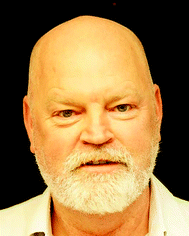Complex coacervation
Paul
Dubin
*a and
Russell J.
Stewart
 *b
*b
aDepartment of Chemistry, University of Massachusetts, 104 LGRT A710 North Pleasant Street, Amherst, MA 01003, USA. E-mail: dubin@chem.umass.edu
bDepartment of Bioengineering, University of Utah, Salt Lake City, UT 84112, USA. E-mail: russell.stewart@utah.edu
 Paul Dubin |
 Russell J. Stewart |
During complex coacervation, the association of water-soluble, oppositely-charged macroions leads to liquid–liquid phase separation when such associates approach electroneutrality. The term coacervation derives from the Latin verb “coacervare”, meaning “to crowd together, to pile up”.1 Complex coacervation driven by non-specific electrostatic associations has been the most thoroughly studied, but other types of weak electronic interactions, such as dipole interactions, π–cation, π–π, and metal coordination, can lead to associative liquid–liquid phase separation.2 Macromolecular ionizable groups in electrostatic systems result in sensitivity of the liquid state to pH and ionic strength. Small changes in such variables can lead to dissolution or solidification of the liquid phase.3
Systems that undergo complex coacervation include polyelectrolyte–polyelectrolyte, polyelectrolyte–colloid, and even colloid–colloid pairs. For all, little is understood about the mechanism and kinetics of complex coacervation, few theories are quantitatively supported by experiment, phenomenology alone fails to predict coacervate stability, and equilibrium behavior is sometimes not confirmed. However, certain features of complex coacervates appear to be quite general. Interfacial tensions of complex coacervates are exceedingly low,4 while macromolecule concentrations are remarkably high and virtually independent of pre-coacervate concentrations. Much of the literature is in fact application oriented. Thus, complex coacervates have found broad technological utility in personal care products, as fat substitutes in reduced calorie foods, for encapsulation of volatile flavors and fragrances, and as water-borne adhesives and coatings. The ability of complex coacervates to contain high concentrations of aggregation-free and fully active proteins has been exploited in the formulation and delivery of growth factors and monoclonal antibodies.
Complex coacervation has a long history in the field of cell biology. The first protocells may have been complex coacervates of abiotic macromolecules that served as liquid containers for early anabolic processes.5 In modern cell biology, regulated intracellular liquid–liquid phase separation of biomacromolecules is known to play fundamental roles in organizing the cytoplasm, assembling transient signaling complexes, and sequestering metabolic pathways.6 Complex coacervates are ideal condensed states of matter for biomacromolecules concentrated and stored in the regulated secretory pathway, destined for secretion as viscous liquids.
To relate complex coacervation to medical science, disruption of normal intracellular complex coacervation, or gain of function mutations leading to abnormal complex coacervation, can cause disease. Benedek7 used the term “molecular condensation disease” to broadly describe cataracts and other pathologies associated with abnormal protein phase separation. “Cold” cataracts are the reversible opacification of the lens by liquid–liquid phase separation of cytoplasmic crystallin proteins. As another example, the leading cause of frontotemporal dementia may be a protein condensation disease caused by mistranslated arginine-rich dipeptide repeat proteins that insert or dissolve into liquid phase-defined intracellular compartments, disrupting their normal function.8 Conceivably, better understanding of the physical chemistry of complex coacervation of biomacromolecules and the role of specific functional groups could lead to treatments for pathological intracellular phase separations.
A session entitled “Coacervation: Physics, Chemistry, and Biology”, organized by Russell Stewart (University of Utah) and Paul Dubin (UMass Amherst), took place at the Spring 2017 National ACS meeting (COLL Division). Topics included: coacervation theory and characterization, liquid–liquid phase separations in cell and proto-cellular systems, and applications in medicine, biomaterials, and industry. This themed collection in Soft Matter brings together research shared in that session, as well as contributions from other groups working in this highly interdisciplinary field. A number of the papers are featured within this issue of Soft Matter, with the remainder appearing in subsequent issues. The entire collection appears online at http://bit.ly/SMCoCo2017.
References
- H. R. Kruyt and H. G. Bungenberg de Jong, Proc. K. Ned. Akad. Wet., 1929, 32, 849–856 Search PubMed.
- C. P. Brangwynne, P. Tompa and R. V. Pappu, Nat. Phys., 2015, 11(11), 899–904 CrossRef CAS.
- Q. Wang and J. B. Schlenoff, Macromolecules, 2014, 47, 3108–3116 CrossRef CAS.
- E. Spruijt, J. Sprakel, M. Stuart and J. Gucht, Soft Matter, 2010, 6(1), 172–178 RSC.
- A. I. Oparin, The Origin of Life, The Macmillan Company, London, 1938 Search PubMed.
- Y. Shin and C. P. Brangwynne, Science, 2017, 357(6357), eaaf4382 CrossRef PubMed.
- G. B. Benedek, Invest. Ophthalmol. Visual Sci., 1997, 38(10), 1911–1921 CAS.
- K.-H. Lee, P. Zhang, H. J. Kim, D. M. Mitrea, M. Sarkar, B. D. Freibaum, J. Cika, M. Coughlin, J. Messing, A. Molliex, B. A. Maxwell, N. C. Kim, J. Temirov, J. Moore, R.-M. Kolaitis, T. I. Shaw, B. Bai, J. Peng, R. W. Kriwacki and J. P. Taylor, Cell, 2016, 167(3), 774–778 CrossRef CAS PubMed.
| This journal is © The Royal Society of Chemistry 2018 |
